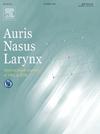Bone dehiscence of the facial canal during transmastoid decompression surgery is a poor prognostic factor in severe Bell's palsy
IF 1.5
4区 医学
Q2 OTORHINOLARYNGOLOGY
引用次数: 0
Abstract
Objectives
To investigate the incidence of facial canal dehiscence and its association with the recovery rate of facial palsy in patients with severe Bell's palsy who underwent transmastoid facial nerve decompression surgery.
Methods
This retrospective study included 142 patients with severe Bell's palsy who underwent transmastoid decompression surgery. The presence of a facial canal dehiscence, the site of the dehiscence, the protrusion of the nerve from the dehiscence, and the recovery rate of facial palsy were investigated.
Results
A bone dehiscence of the facial canal was observed in 50 patients (35.2 %) during surgery, with most (92.5 %) being located in the tympanic segment. Protrusion of the facial nerve from the dehiscence was observed in 25 patients (17.6 %). The recovery rate of facial palsy was significantly better in patients without dehiscence of the facial canal (57.6 %) compared to those with bone dehiscence but lacking protrusion of the nerve (32.0 %; p = 0.044) or those having a bone dehiscence with protrusion of the nerve (28.0 %; p = 0.011).
Conclusion
Patients exhibiting dehiscence of the facial canal during transmastoid decompression surgery for severe Bell's palsy demonstrate a diminished recovery rate in comparison to those without dehiscence of the canal.
经乳突减压术中面椎管骨裂是严重贝尔氏麻痹预后不良的因素。
目的:探讨重度贝尔氏麻痹患者行经乳突面神经减压术后面神经管破裂的发生率及其与面瘫康复率的关系。方法:回顾性研究142例经乳突减压手术的重度贝尔氏麻痹患者。探讨面神经管破裂的存在、部位、神经突出情况及面神经麻痹的恢复情况。结果:术中出现面管骨裂50例(35.2%),其中大部分(92.5%)发生在鼓室段。面神经突出25例(17.6%)。面神经管无裂患者的恢复率(57.6%)明显优于有骨裂但无神经突出的患者(32.0%;P = 0.044)或有骨裂伴神经突出者(28.0%;P = 0.011)。结论:重度贝尔氏麻痹经乳突骨减压术中出现面神经管破裂的患者比无面神经管破裂的患者恢复率低。
本文章由计算机程序翻译,如有差异,请以英文原文为准。
求助全文
约1分钟内获得全文
求助全文
来源期刊

Auris Nasus Larynx
医学-耳鼻喉科学
CiteScore
3.40
自引率
5.90%
发文量
169
审稿时长
30 days
期刊介绍:
The international journal Auris Nasus Larynx provides the opportunity for rapid, carefully reviewed publications concerning the fundamental and clinical aspects of otorhinolaryngology and related fields. This includes otology, neurotology, bronchoesophagology, laryngology, rhinology, allergology, head and neck medicine and oncologic surgery, maxillofacial and plastic surgery, audiology, speech science.
Original papers, short communications and original case reports can be submitted. Reviews on recent developments are invited regularly and Letters to the Editor commenting on papers or any aspect of Auris Nasus Larynx are welcomed.
Founded in 1973 and previously published by the Society for Promotion of International Otorhinolaryngology, the journal is now the official English-language journal of the Oto-Rhino-Laryngological Society of Japan, Inc. The aim of its new international Editorial Board is to make Auris Nasus Larynx an international forum for high quality research and clinical sciences.
 求助内容:
求助内容: 应助结果提醒方式:
应助结果提醒方式:


